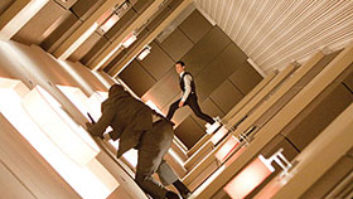With just three major films under his belt, director Christopher Nolan has already proven to be a true master of complex, psychological dramas. First with Following (1998), then the brilliant, critically acclaimed Memento (2000), and now with Insomnia (which opened in late May), Nolan gets the viewer inside the heads of his troubled characters in ways that few directors do. He also knows how to tell good stories in unusual ways, sort of like a twisted Hitchcock. People and things in his films are never quite what they seem to be, which only adds to the suspense, of course.
Insomnia is a perfect addition to Nolan’s oeuvre. It was originally a 1997 Norwegian film directed and co-written by Erik Skjoldbjerg. An English-language screenplay by Hillary Seitz transfers the story to Alaska, where a detective (Al Pacino) brought in to investigate the murder of a young girl is blackmailed by a sadistic killer (Robin Williams), who witnessed the detective’s accidental killing of his own partner. It’s Pacino’s Will Dormer character who is afflicted by the sleeplessness of the title; as the film goes on, his senses become more distorted, he’s increasingly disoriented, and once again we are trapped in an uncomfortable reality of Chris Nolan’s making.
Not surprisingly, sound plays a key role in communicating the full dimensions of Will Dormer’s insomnia. Charged with the responsibility of sonically depicting Dormer’s inner world was supervising sound editor Aaron Glascock, who has worked as an editor under Mix “Sound for Film” columnist Larry Blake on most of Steven Soderbergh’s films, and on such movies as The Green Mile, Osmosis Jones, The Fifth Element and October Sky. (Co-supervising sound editor Curt Schulkey primarily handled dialog/ADR, while Glascock did effects.)
“This was a dream project for me,” Glascock says. “I love to be challenged, and having seen Memento, I knew that Chris Nolan’s approach was not going to be predictable. I thought, if I’m a tool for him to execute his film, I’m going to be used well and challenged much like an audience member, and that was the case.”
Glascock says that Nolan and film editor Dody Dorn (herself a former sound editor) were determined from the outset “to integrate the picture department and the sound department as early as possible in order for sound development to have an effect on editorial. My approach to sound is that it’s a dimension, and if you wait until the last minute, you’re only going to benefit the film so much. I wanted, as soon as possible, to get into the language of the film. Every film has its own language and you have to learn it. So the more time you can spend with the film, the more you can understand the signals the film is giving you.”
Much of the film takes place outdoors, and Glascock spent considerable time gathering sounds around Stewart, B.C., near the southern border of Alaska. “We recorded everything from backgrounds to hard effects that were part of the locale, including a logging area,” Glascock says. “There’s a lot of variety to the sound in this film. There are chases, a sequence that takes place underwater in the middle of a logjam, guns, all sorts of things.” Glascock recorded his location-based effects on a 4-channel Zaxcom Deva. “The sonic result is excellent,” he comments. “I shot a lot of quad backgrounds and presences, but it’s very subtle.” (Most interiors in the film were shot on soundstages in Vancouver, with Larry Sutton working as the location mixer.)
From a sound perspective, capturing the sound of the insomnia was Glascock’s most difficult task. “It’s displayed in many different ways,” Glascock notes. “There are visions and dreams and flashbacks, and they are all handled in different ways. For sound, I was thrilled because it’s a very diverse sound spectrum that we came up with. It’s not one sound gimmick that’s used over and over. And it’s not just a fantasy land of weird sounds. There’s an overall kind of shifting sound of his mind as he goes deeper and deeper into his fatigue, so the things that he hears become very altered; some things are more extreme than others, and it’s constantly changing.”
Much of the sound design work for the insomnia involved creating odd, internal ambiences. “We’d take the sound of tumbling rocks and pitch that, put delays on it and even pitch the delays in different ways. Or, we’d alter the sound of a stream or some kind of very heavy, dynamic, powerful sound and make an air presence out of it. There are all kinds of subtle things — like the sound of light hitting this tired guy’s eyes. We used a bowed saw blade, worked with that and made a sort of white noise out of a ringing metallic sound. I first started with a modified rain splatter and then a hydrophone recording of snapping shrimp.”
The post work was done at Weddington Productions, with mixing at Todd West by Mike Minkler and Myron Nettinga, two-thirds of last year’s Oscar-winning team for Black Hawk Down. “They did a fantastic job,” Glascock enthuses.
“This film has a surface that is very accessible to somebody who only wants to look that far, but if you want to go deeper, you will definitely find things. It’s the kind of movie that gets you to open up and use your ears like your eyes.”




